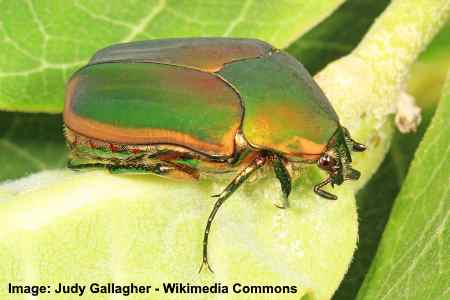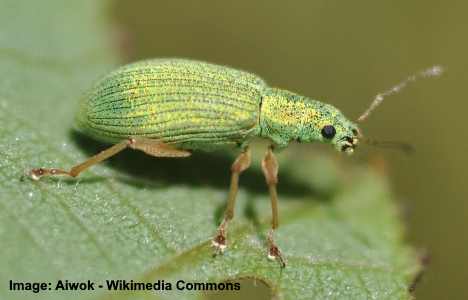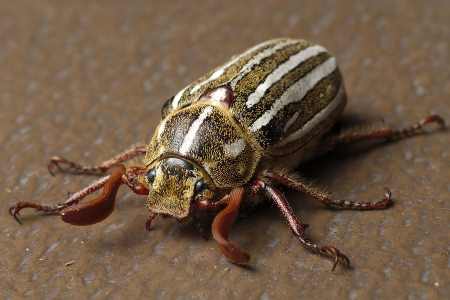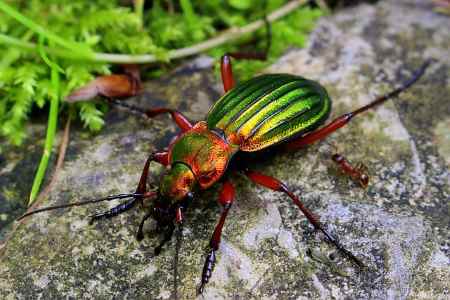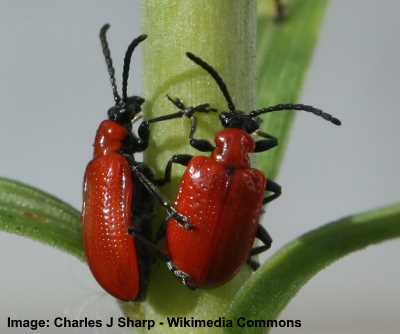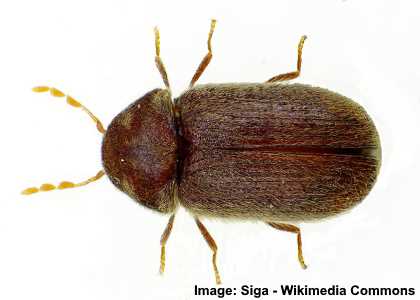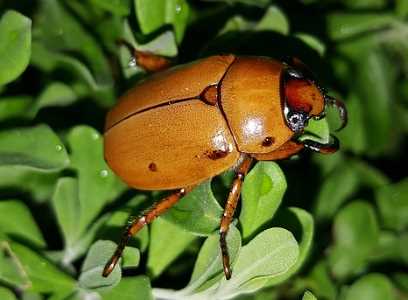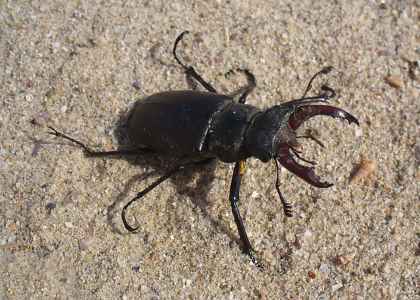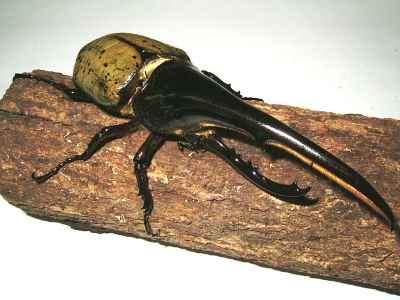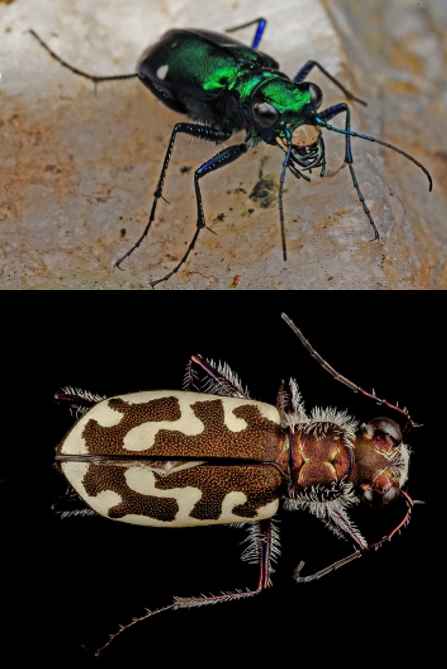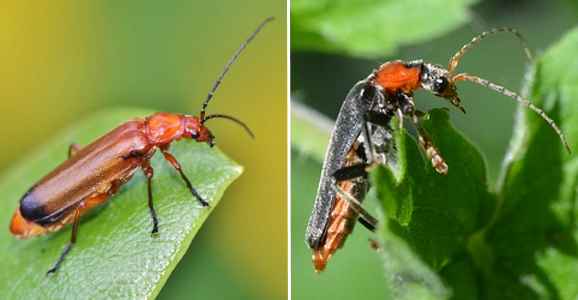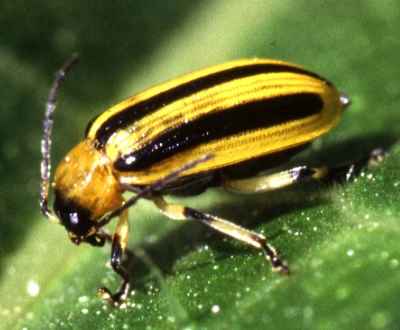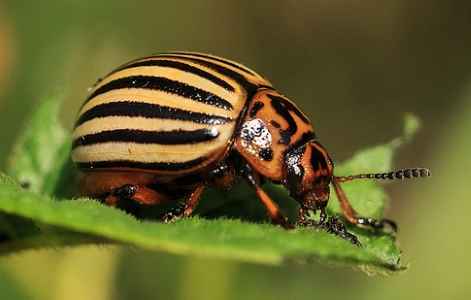Types of Beetles With Pictures and Identification Guide (Green, Black, and More)
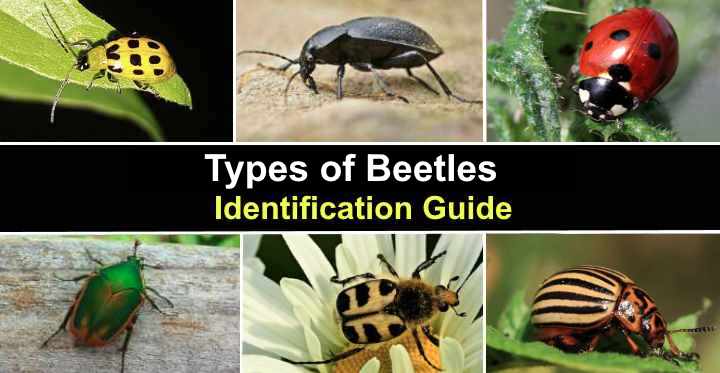
Beetles are some of the most fascinating types of insects that you will come across. Many types of beetles are harmless and can be beneficial for gardens or backyards. However, there are also some beetle species that can destroy plants or vegetation. Identifying beetles by their color, body shape, and other features can help to know which type of beetle you have.
All types of beetle are anthropoids (phylum Arthropoda) that belong to the order Coleoptera. There are over 400,000 species of beetles that are divided into families and subgroups. Some types of beetles can fly and others bite. In fact, the old English word for beetle literally means “little biter.”
Insects in the beetle order can range in size from very small to relatively large. The smallest species of beetle is also the smallest insect in the world. The Scydosella musawasensis beetle is less than 1 mm long! The largest beetle, the Titan beetle, can grow to nearly 7” (17 cm)! However, the average size of most beetles is under 1” (2.5 cm) long.
Although many beetle species are black, beetles can be a range of colors from green to brown, red, or orange. Some of the most stunning varieties of beetles have iridescent coloring with shades of metallic colors. Others can have striped, speckled, or patterned bodies. One type of small red beetle with black spots that flies is the ladybug or lady beetle.
Beetles vs. Bugs
Many people refer to beetles as bugs. However, true bugs in the order Hemiptera are not the same as beetles. Beetles are winged insects in the order Coleoptera, and they have chewing mouthparts called mandibles. Bugs, instead, have piercing, sucking mouthparts they use to bite plant tissue or skin.
The difference between beetles and bugs gets confusing because some beetles have the word “bug” in their common name. For example, ladybugs (Coccinellidae), potato bugs (Leptinotarsa decemlineata), lightning bugs (Lampyridae), and clay-colored billbugs (Sphenophorus aequalis) are all beetles in the order Coleoptera.
However, most people refer to any small pesky critters with legs as bugs, whether tiny beetles, caterpillars, spiders, ants, flies, or ticks.
Beetle Identification
Beetles are classified into groups of insects that have hard exoskeletons, wings, and most species have pincers or mandibles on their front. Lower classifications of beetles are categorized by their ability to fly, colors, long antennae, swimming ability, and head shape.
Because the list of beetle types is extremely long, it can be challenging to identify the exact beetle species.
Types of Beetles with Their Picture and Name: Identification Guide
Let’s look at some of the most common beetles you are likely to find in your garden, in forests, or scurrying through your house.
Figeater Beetle (Green Fruit Beetle)
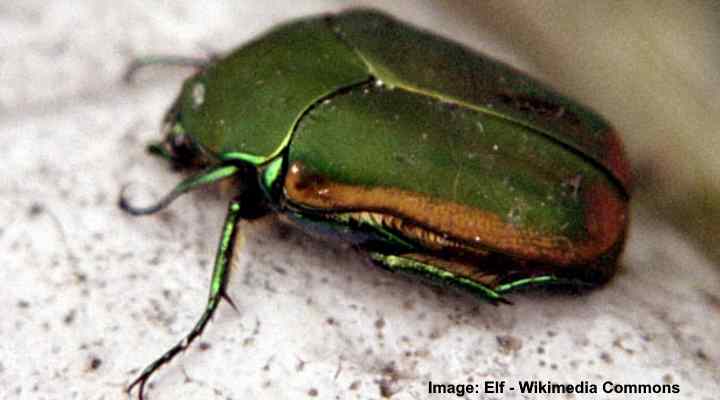
The figeater is a type of green flying beetle that is active during daytime
The figeater beetle (Cotinis mutabilis) is a green-colored beetle that is commonly found in yards, compost heaps, and mulch. Belonging to the beetle family Scarabaeidae, “fig” beetles have a semi-glossy green shell with orange-colored edges. Turning the beetles over, you will notice striking metallic green belly and legs.
Figeaters are the most widespread beetle in their subgroup. These are also a species of flying beetle and can make a lot of noise flying through the air. Due to their beautiful iridescent colors, they are also classed as jewel beetles.
Figeater beetle identification
- Found in Southwestern U.S. states and near decaying material.
- Short head and short antennae.
- Size 0.6” to 1.3” (17 to 34 mm).
Green June Beetle (Cotinis nitida)
Another type of large green beetle is the green June beetle in the lower classification Scarabaeidae (scarab beetle). This beetle from the genus Cotinis is related to the figeater beetle with similar coloring to its cousin. One of the differences between the 2 species is that the green June beetle is more destructive. It is also sometimes mistaken for the smaller Japanese beetle.
The green June beetle gets its name from the fact it is prevalent in early summer during the day. This green flying beetle loves to feed on ripening fruit and use the horn in the front of their body to dig into the fruit. The dull green wing covers (elytra) on its back protect delicate brown wings.
Green June beetle identification
- Found throughout the southern states in the U.S. feeding on juicy fruits.
- Short antennae with copper-colored edges on its green body.
- Size 0.75” to 1” (20 to 25 mm).
Pale Green Weevil Beetle
Polydrusus impressifrons is the scientific name of the pale green weevil beetle. Compared to other types of green beetles, the green weevil has a slender pale green body and long antennae. When getting ready to fly, the green weevil raises its wing covers to reveal a brown to black body.
Species of weevil beetles belong to the lower group of beetles called Curculionidae which is the largest of the beetle families. There are over 83,000 species of weevil beetles. This particular species is small and has brownish or orange-colored legs and antennae of the same color.
Pale green weevil beetle identification
- Found throughout North America feeding on tree leaves. They are only destructive to tree saplings.
- Its light green body acts as camouflage when it is feeding on leaves.
- Size 0.2” to 0.27” (5 to 7mm).
Ten-lined June Beetles (Brown Type of Beetle)
June beetles belong to the family Scarabaeidae and there are a number of brown beetles in this category. As the name of this large beetle suggests, the identifying feature is white stripes on its back. This brown-colored beetle also has large antennae that look like curved paddles.
You can usually see these striped brown and white beetles in early summer. They like to feed on plant roots and therefore can be destructive insects. You also may hear a hissing noise from them if they feel threatened.
Ten lined June beetle identification
- This scarab beetle is found in the western regions of North America.
- Elongated oval brown glossy body with white stripes running vertically.
- Size 0.8” to 1.4” (20 to 35 mm).
Ground Beetle
There are thousands of species of ground beetles that belong to the family Carabidae. One of the most striking of the ground beetles is the golden ground beetle (Carabus auratus). This has an iridescent shiny green body with an almost mirror-like sheen. They also have brownish-red spindly legs.
Other types of ground beetles can have shiny black bodies and rusty-brown heads or grayish-brown bodies with shaped patterned markings. There are around 2,000 species of ground beetles in North America.
Ground beetle identification
- Found scurrying across the soil to feed on insects, worms, or snails.
- Identified by their shiny green or black bodies and long legs.
- Size 1.5” (35 mm).
Red (Scarlet) Beetle / Lily Beetle
The scientific name for red lily beetles is Lilioceris lilii and they are a member of the family Chrysomelidae. As their common name suggests, these are small red beetles that love to feed on lily leaves. One of the first signs of a red beetle infestation is chewed lily plants.
These tiny beetles have bright red wing covers and jet-black antennae, belly, and legs. The red lily beetles are often confused for cardinal beetles (Pyrochroa serraticornis) which have a similar red and black appearance. Because of their love for lily plants, they are a garden pest if you want to grow true lilies.
Scarlet lily beetle identification
- Originally from Europe, the scarlet lily beetle is a destructive garden pest now found in Canada and the U.S.
- Brilliant red body with no distinct markings apart from a tiny black triangle behind their thorax. They also have long black antennae.
- Size 0.25” to 0.35” (7 to 9 mm).
Drugstore Beetle
One species of brown beetle from the family Ptinidae is the drugstore beetle (scientific name: Stegobium paniceum). This tiny flying brown beetle is also named the biscuit beetle or bread beetle and is similar in appearance to the cigarette beetle.
As its name suggests, drugstore beetles love to feed on stored products. However, they have a vivacious diet and they also munch on spices, dried foods, cookie crumbs, paper, and old leather. Adult brown beetles have a cylindrical body that is covered in fine hairs and have an appearance of lines along its body.
Drugstore beetle identification
- Found throughout the world, these destructive small brown beetles can destroy grains, seeds, and other dried foods.
- They have a pair of antennae with serrated edges.
- Size 0.07” 0.13” (2 to 3.5 mm).
Grapevine Beetle
The grapevine beetle is another of the types of June beetles in the family Scarabaeidae and subfamily Rutelinae. This scarab beetle is light orange or pale auburn in color with black lines dividing the wing covers and thorax. Its other name, ‘spotted June beetle’ comes from the 4 dots on the side of its body.
Although the large brownish beetle feeds on grapevine leaves, it doesn’t cause enough damage to be classified as a pest. You will often find the grapevine beetle in forests woodlands, and bushes. If the beetles get disturbed or startled, they will quickly fly away.
Grapevine beetle identification
- Found in eastern regions of North America and some states in the central U.S.
- Large orange and black colored beetle.
- Size 1” to 1.2” (25 to 30 mm).
Black Carpet Beetle
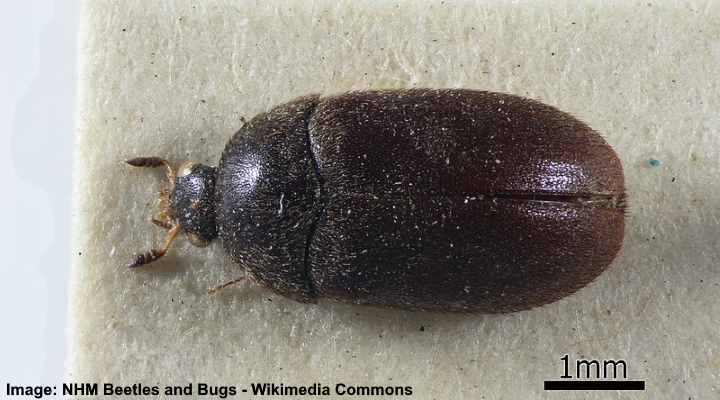
The small black carpet beetle is an indoor invasive pest
The common name of the beetle species Attagenus unicolor is black carpet beetle. There are nearly 200 species of carpet beetles in the subfamily Attageninae. These small dark-colored beetles are an invasive pest in many homes. Their larvae can chew through fabric, damaging clothing, furniture coverings, and carpets.
If you notice holes in your furnishings and evidence of carpet beetles, it is important to get rid of the larvae. The hairy brown grubs can stay in their larval stage for up to 3 years. During this time, they can cause destruction to carpets and cloth items.
Black carpet beetle identification
- Carpet beetles are found indoors wherever any sort of organic material is stored.
- An elongated oval body that becomes black as the adult beetle matures.
- Size 0.12” to 0.2” (3 to 5 mm).
Stag Beetles
Stag beetles get their name from the large mandibles or pincers that the males have. The horn-like protrusions on the front of their body give these large black beetles a menacing look. The females also have pincers on their head but these are smaller than the males ‘antlers.’
Stag beetles belong to the family Lucanidae and there are 4 subfamilies in the group. These are also a type of large black beetle and are one of the largest land insects in temperate regions. Although the males can be aggressive to each other, they rarely bite humans with their mandibles.
Stag beetle identification
- Found in Europe, the United States, and Canada.
- Large beetles with dark shiny bodies and pincers like antlers.
- Size 2” (5 cm). Some species of stag beetle grow up to 4.7” (12 cm)
Hercules Beetles
As the name suggests, Hercules beetles are a large and impressive type of beetle. These horned beetles belong to the subfamily Dynastinae and are a scarab beetle. Beetles from this group are also referred to as rhinoceros beetles.
There is a wide variation in the different species of Hercules beetles. Their hard wing covers can be light brown, green, or gray colors with black markings. These markings are unique to each individual beetle. Some species of Hercules beetles have a huge protruding horn that they use to battle with other beetles.
Another interesting fact about this large beetle is that it is one of the largest flying insects in the world. The species Dynastes tityus is also the heaviest insect in North America. These types of beetles are also popular pets in some countries.
Hercules (rhinoceros) beetle identification
- Found in the United States and northern Mexico.
- A massive beetle that, despite its aggressive look, is not harmful to humans.
- Size 1.6” to 2.4” (40 to 60 mm) long and up to 1” (2.5 cm) wide.
Tiger Beetle
Looking at pictures of a tiger beetle, it can be easy to mistake this for a completely different species of insect. Tiger beetles have long skinny legs, long antennae, and curved mandibles. These aggressive beetles belong to the subfamily Cicindelinae.
There are over 2,600 species of beetle in this group with many variations in body color, size, and shape. Some genera can be brightly colored whereas other kinds of these beetles are dull black bugs. The six-spotted green tiger beetle is bright iridescent green.
One identifying feature most have in common is their long legs and ability to run fast.
Tiger beetle identification
- Found in most regions of the world, this flying beetle seems to prefer deserts and hot climates.
- Abnormally large head with two sickle-shaped jaws to catch and eat its prey.
- Size 0.4” to 0.78” (10 to 20 mm).
- Some species have been known to run up to 2.5 m/s!
Soldier Beetle
Soldier beetles from the family Cantharidae have long straight bodies without any curvature. These black and orange flying insects are often seen flying around flowers and can be easily mistaken for wasps. Many species of soldier beetle have a different colored head and thorax from the rest of their body.
This species of beetle gets its name from its unique shape which is said to resemble British red coat soldiers. Unlike many of the other kinds of beetles, its wing covers are softer and leathery. Because of this, they are also given the name ‘leatherwings.’
Soldier beetle identification
- Found in most countries in the Western Hemisphere.
- Harmless beetles with long antennae.
- Size 1” (25 mm).
Sawyer Beetles
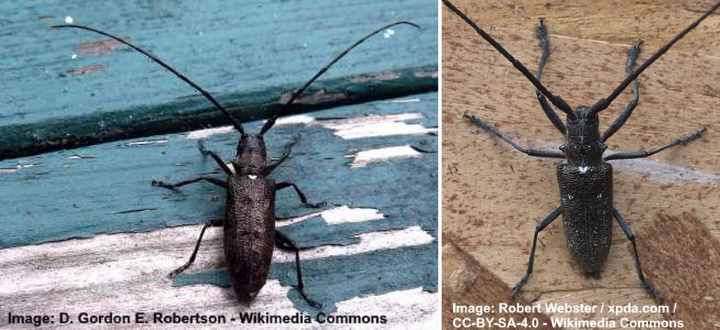
The white-spotted Sawyer Beetle (Monochamus scutellatus) has long antennae and may have white spots on the body
Sawyer beetle is the common name of beetles in the genus Monochamus. The common name of these insects comes from their ability to drill into types of softwood. Sawyer beetles are a large type of longhorn beetle that fly and are attracted to lights. One of the ways to recognize these dark-colored beetles is by their extremely long antennae. With some species of sawyer beetle, their antennae can be longer than their body length.
The reason why sawyer beetles are considered an invasive pest is the damage they do to pine wood. A sawyer beetle infestation can destroy up to 40% of the value of pine logs due to tunnels they bore in the wood. Some species of this beetle also have the word ‘pine’ in the common name. For example, the spotted pine sawyer (M. clamator), black pine sawyer (M. galloprovincialis), and the Japanese pine sawyer beetle (M. alternatus).
Sawyer beetle identification
- Found mainly in forested areas, especially where pine trees are prevalent.
- Long antennae that can grow up to 2” (50 mm) long.
- Size 0.7” to 1.06” (18 to 27 mm).
Japanese Beetle
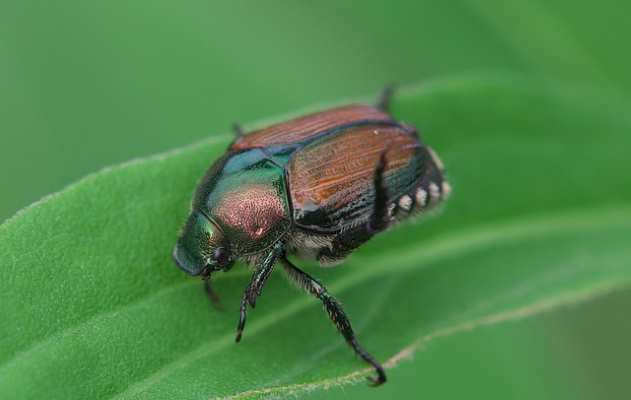
Japanese beetles have iridescent green and copper colors and white tufts on each side
The Japanese beetle (Popillia japonica) is a medium-sized beetle with stunning iridescent copper-colored hard wing covers and a shiny green head. Although this scarab beetle is native to Japan, it is now an invasive species in North America and Europe. The beetle feeds on the plant leaves of over 300 species.
This metallic green and bronze beetle has an oval body that is almost as wide as it is long. Apart from its iridescent coloring, the beetle is identified by its tufts of tiny white hairs under the elytra (wing covers).
Japanese beetle identification
- Found feeding on fruit and leaves of many types of plants. The larvae live in the ground and love eating roots of grasses.
- Size 0.6” (15 mm) long and 0.4” (10 mm) wide.
Striped Cucumber Beetle
The striped cucumber beetle (scientific name: Acalymma vittatum) is a tiny beetle in the genus Acalymma and subfamily Galerucinae. As you can guess from its name, the striped markings help to identify this beetle. Black and yellow stripes run the length of its wing covers.
This little black and yellow beetle is a serious crop pest and is similar in its look to the western corn rootworm beetle (Diabrotica virgifera). You can tell the beetles apart because the striped cucumber beetle has a black abdomen.
Striped cucumber beetle identification
- Found on edible leaves of plants such as cucumbers, pumpkins, melons, and zucchini.
- Striped markings help to identify this destructive leaf beetle.
- Size 0.5” (13 mm).
Colorado Potato Beetle
Another striped leaf beetle that can do major damage to crops is the Colorado potato beetle (Leptinotarsa decemlineata). The almost round-looking beetle has orange or light-yellow and brown stripes. It is not just potato crops that they decimate, these ‘potato beetles’ also feed on other plants in the nightshade family.
Colorado beetles shouldn’t be confused with Jerusalem ‘beetles’ that are called potato bugs.
Colorado beetle identification
- Found feeding on crops in North America and Europe.
- They quickly fly from plant to plant and have ten stripes on their backs.
- Size 0.24” to 0.43” (6 to 11 mm).
Other Type of Flying Beetles
There are some types of true beetles that many people tend to associate with other types of flying insects.
Ladybug
Although commonly called ‘ladybugs,’ these delightful winged insects are a type of beetle in the family Coccinellidae. The term ‘lady beetles’ is the more correct name for these red beetles with black spots. Species of ladybugs (or, ladybirds) are beneficial beetles that are good for controlling aphid populations.
Learn more about the many different types of ladybugs that inhabit gardens and grasslands in the summer.
Fireflies
Even though they are called fireflies, these interesting insects are a member of the beetle family Lampyridae. The most fascinating of the species are the nocturnal fireflies that glow in the dark. For this reason, they are also called glowworms in some countries.
Fireflies grow up to 1” (2.5 cm) long and they use chemical lights to attract prey and mates.
Mexican Bean Beetle (Epilachna varivestis)
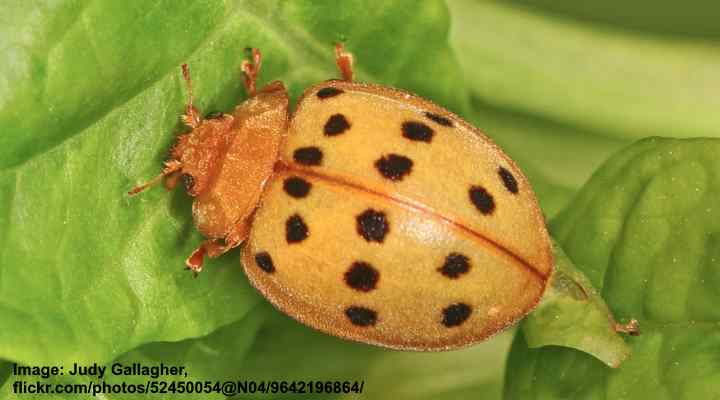
The small orange Mexican bean beetle is covered in black spots and feeds on bean plants
The Mexican bean beetle is an orange beetle with rounded, oval elytra covered in black spots. This black-spotted orange beetle has an orange head, thorax, and two clubbed antennae. The Mexican bean beetle is a type of ladybug measuring 0.23” to 0.27” (6 – 7 mm).
You can find this orange beetle feeding on flowers and seed pods of plants in the family Fabaceae. The bean-loving beetles can damage plants by skeletonizing foliage. However, the tiny pill-shaped beetle larvae do the most damage to plants. Although orange is its most common color, the lady beetle can also be yellow or red.
Mexican bean beetle identification
- Rounded shape with a bright orange color and black spots.
- The Mexican bean beetle is found feeding on bean plants.
- Common throughout the eastern United States.
Red-Headed Cardinal Beetle (Pyrochroa serraticornis)

The red-headed cardinal beetle is completely red except of the black legs and antennae
The common cardinal beetle is a brightly colored red or dark orange beetle. The red-headed cardinal beetle has a distinctive narrow red thorax and head with black serrated antennae and legs. In addition, the red beetle has tiny black mandibles resembling small antennae. This species of red beetle grows up to 0.59” (15 mm).
The red-headed cardinal beetle is a species of fire-colored beetle. Its elongated oval shape and vibrant color make the beetle easy to spot on vegetation. You will often find it when it’s most active in summer, scurrying over tree and shrub foliage in woodlands and parks.
The common cardinal beetle is often confused with the black-headed cardinal or scarce cardinal beetle. Both are species of red beetle, but they have black heads. These red beetles can be beneficial insects because they feed on small insects and larvae.
Red-headed cardinal beetle identification
- The cardinal beetle can be easily identified by its red body with black legs and antennae.
- You can find the red beetle basking on flowers and leaves on warm summer days.
Clay-Colored Billbug (Sphenophorus aequalis)
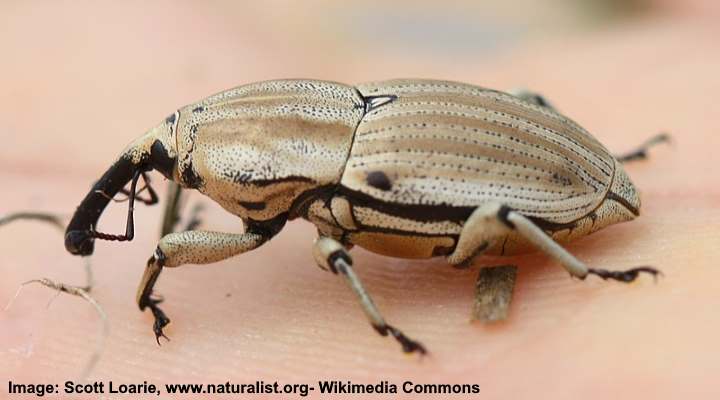
The clay-colored billbug is a type of weevil and is identified by its long snout and gray and beige colors
The clay-colored billbug is a distinctive beetle species with gray and tan striped wing covers, thorax, and a long snout. The beetle’s curved beak is characteristic of all types of weevils. The mid-sized stripy beetle grows 0.5” to 0.75” (13 – 19 mm) long.
Although called a bug, the beetle is not a true bug in the order Hemiptera. Instead, it’s a gray to tan-colored insect in the beetle order Coleoptera and family Curculionidae.
Clay-colored weevils can do a lot of damage to corn crops when they emerge from the soil in May. The small beetles chew three or four holes in leaves with their beaks, and they can kill small plants. The bug-like beetles usually have a thin covering of soil on their backs.
Clay-colored billbug identification
- The gray-colored billbug beetle has a distinctive black snout and six short, stumpy legs.
- Look for the dark brown or black band along the sides of its abdomen.
Red Milkweed Beetle (Tetraopes tetrophthalmus)
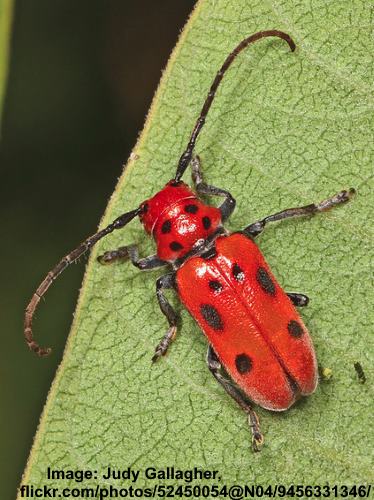
The red milkweed beetle has elongated body with black dots
The red milkweed beetle is a type of brightly red-colored longhorn beetle with black spots. Other distinguishing features of the black-spotted red beetle include its black underside, legs, and long, curved antennae. These red and black beetles measure 0.31” to 0.59” (8 – 15 mm). The red beetles are active in the summer.
As their common name suggests, the host plant of red milkweed beetles are plants in the milkweed genus Asclepias. The sap and plant tissue build up toxins in the insect, making the red beetle poisonous to some birds and predators. Another identifying feature of the bright red beetle is the shrill noise it makes when startled.
Red milkweed beetle identification
- The red milkweed beetle is identified by its shiny red head, thorax, and elytra covered in small black patches.
- Its bright red coloring acts as a warning to potential predators.
Ninebark Calligraphy Beetle (Calligrapha spiraea)

The beautiful ninebark calligraphy beetle has a bright red rounded body with black markings
The ninebark calligraphy beetle is a shiny bright red leaf beetle with black spots, stripes, and curved patterns on its wing covers. The red and black insect has a shape like a ladybug and measures 0.23” to 0.27” (6 – 7 mm) long. Its distinctive domed body, red antennae and legs, and black thorax and head make it easily recognizable.
This red beetle gets its common name from the calligraphy-like markings on its back. You’ll often find the vibrantly-colored beetle feeding on ninebark plants (Physocarpus opulifolius). Despite the plant species spirea in the botanical name, this was from when ninebark was classed in the same genus as spirea shrubs.
Ninebark calligraphy beetle identification
- Glossy red wing cases covered in black spots and twisting black markings.
- A dome-shaped body like a red ladybug.
Pedunculate Ground Beetles (Scarites spp.)
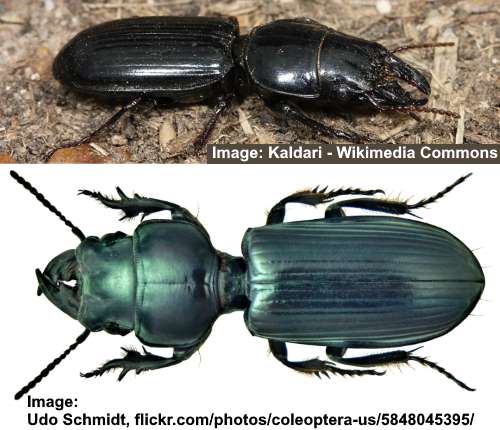
Pedunculate ground beetles (Scarites spp.). Top picture: Scarites subterraneus (big-headed ground beetle). Bottom: Scarites linearis
Pedunculate ground beetles are shiny black, sometimes metallic green insects with large distinctive pincers, an oval abdomen, and a recognizable thin waist. Other characteristic features of these ground beetles are their powerful mandibles, spiny legs, and serrated antennae. The large beetles measure 0.55” to 1.18” (14 – 30 mm).
Pedunculate beetles are classified as ground beetles because they burrow into the soil. Active in spring and summer, you’ll find the large black beetles under logs, mulch, stones, and leaf litter. They feed on larvae, bugs, and small insects using their large pincers.
Other characteristics of the ground beetles are their ribbed wing cases, large heads, and skinny waists. Looking closely, you’ll notice two small indentations on their heads.
Pedunculate ground beetle identification
- They have elongated oval wing cases with noticeable ridges.
- Look for the exceedingly thin waist between prothorax and elytra and large pincers.
Pennsylvania Ground Beetles (Harpalus spp.)
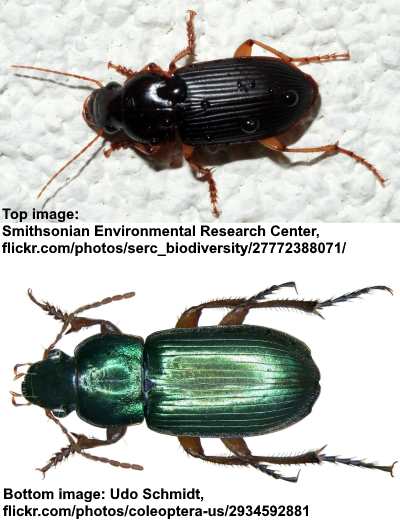
Top image: Pennsylvania ground beetle (Harpalus pensylvanicus). Bottom: Harpalus affinis
Pennsylvania ground beetles are a type of black or metallic green carabid beetles with brown legs and antennae. Identifying features of the mid-sized beetles are their ridged elytra, spiny legs, and depression on their thorax. There are over 400 species of beetles in the genus Harpalus, and they can be bronze, green, or black.
Pennsylvania ground beetles are regarded as beneficial insects because they feed on the larvae of plant pests and bugs. The black beetles are also useful for controlling cucumber beetles, caterpillars, and aphids. However, they can also feed on plants like foxtail, lambsquarters, and redroot pigweed. In addition, the beetles can act like bugs when they attack ripening strawberries.
Pennsylvania ground beetle identification
- The beetles have a shiny body with ribbed elytra and smooth head and thorax.
- They have brown legs and serrated antennae.
- The black beetles can be pests in homes during spring and summer.
False Bombardier Beetle (Galerita bicolor)
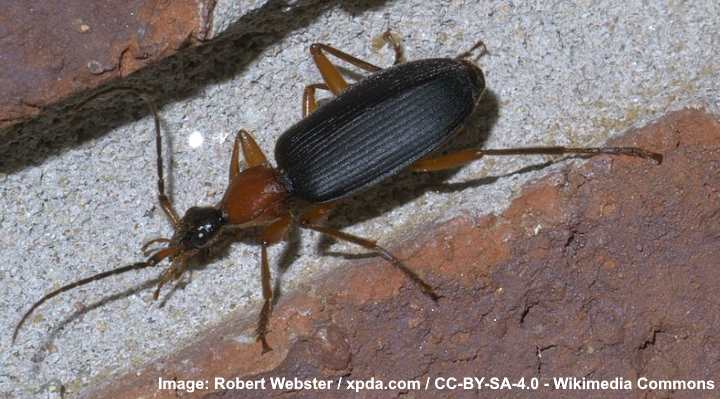
The black and dark orange false bombardier beetle has a long and slender body and is relatively large
The false bombardier beetle is a black beetle with reddish-brown legs, thorax, and a slender black head. This ground beetle species is easily identified by its ridged black elytra, long spindly legs, and thick orange segments on its antennae. The relatively large beetle measures 0.66” to 1” (17 – 25 mm).
As its name suggests, the black and dark orange beetle looks like the bombardier beetle. However, the beetles are larger than bombardier beetles. You’ll often find them under leaves, stones, and scurrying around open woodlands. They are attracted to lights and can become a nuisance pest indoors.
False bombardier beetle identification
- The beetle has a matte black back, orange-brown legs, thorax, antennae, and a slender black head.
- Look for linear ridges on its oval elytra.
Stenolophus Ground Beetles (Stenolophus spp.)
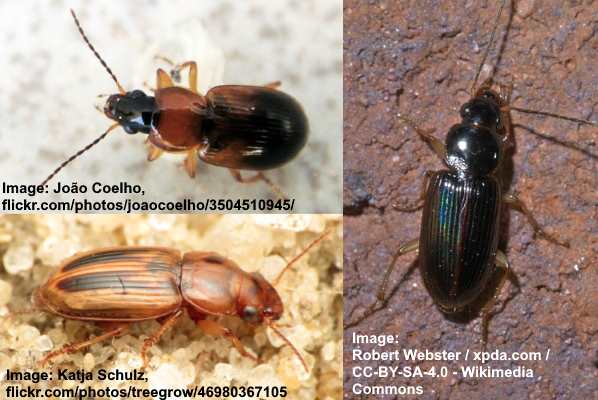
Stenolophus ground beetles. Clockwise from top left: Stenolophus tentonus, Stenolophus ochropezus and Stenolophus lineola
Stenolophus ground beetles are a common carabid beetle species with slender oval black and brown bodies and thread-like antennae. Some species are shiny and black, whereas other stenolophus beetles are orange-brown with black or dark brown markings on their backs. Typically, these ground beetles measure 0.19” to 0.31” (5 to 8 mm).
Also called seedcorn beetles, the small black or brown insects feed on seed corn and can decimate whole crops or infest stored grain.
Stenolophus ground beetle identification
- Small black or brown beetles with long antennae and linear grooves on their elytra.
Spotted Yellow Cucumber Beetle (Diabrotica undecimpunctata)
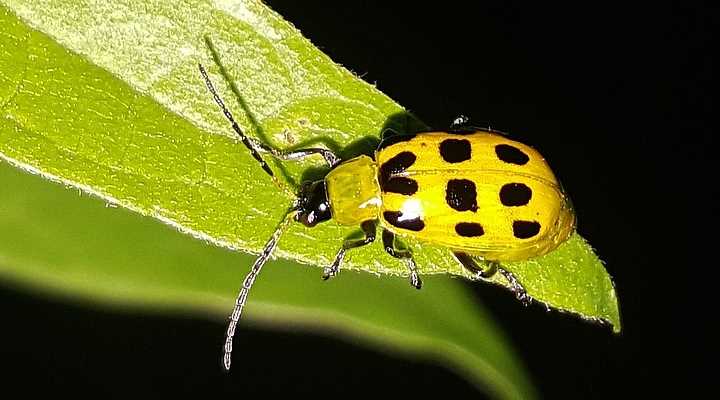
The spotted yellow cucumber beetle has black spots on its yellow wing covers
The spotted cucumber beetle is a small, round yellow beetle with six black spots on each of its wing cases. The oval, domed shape and spotted elytra make this beetle look like a yellow ladybug. Other distinguishing features include its yellow thorax, black head, legs, and antennae. The spotted cucumber beetle measures 0.25” (6 mm).
Suppose you notice a yellow beetle on cucumber plants with black stripes on its elytra. In that case, it is probably the striped cucumber beetle (Acalymma vittatum). These yellow beetles feed on cucurbit crops like cucumber and squash during spring and early summer.
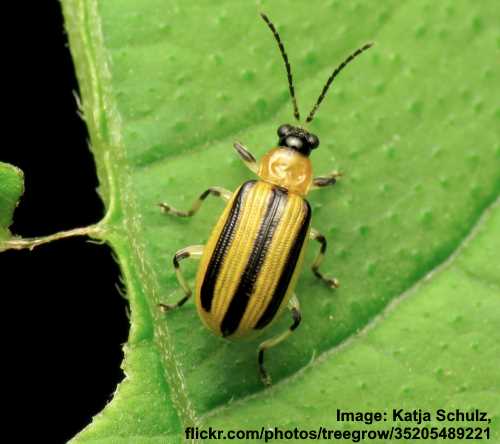
The striped yellow cucumber beetle is a destructive pest with 3 black stripes on its yellow body
Spotted cucumber beetle identification
- The beetle has a domed yellow elytra with 12 black spots, a yellow thorax, and a black head.
- Common on plants related to cucumbers.
Black and Yellow Longhorn Beetle (Rutpela maculata)
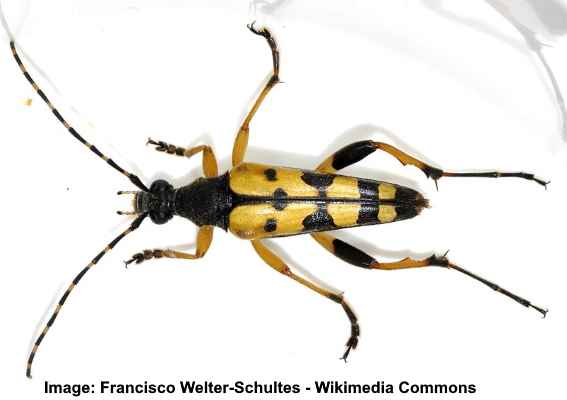
The black and yellow longhorn beetle is identified by its elongated body with black dots and stripes on its yellow body
The black and yellow longhorn beetle is a medium-sized beetle with recognizable black markings on its yellow elytra. The yellow and black beetle has a slender abdomen tapering to a point. The beetle also has black-banded yellow legs and black and yellow striped antennae.
The black and yellow longhorn beetle measures 0.5” to 0.78” (13 – 22 mm). You will find the black-spotted beetles feeding on plant nectar when they are active from May until August. The beetles also commonly live on oak, poplar, willow, ash, and beech trees.
Black and yellow longhorn beetle identification
- Black and yellow longhorns are identified by their distinctly patterned black and yellow elytra.
- Look for long, arching black antennae with yellow bands.
Yellow-Bellied Garden Fruit Chafer Beetle (Pachnoda sinuata flaviventris)
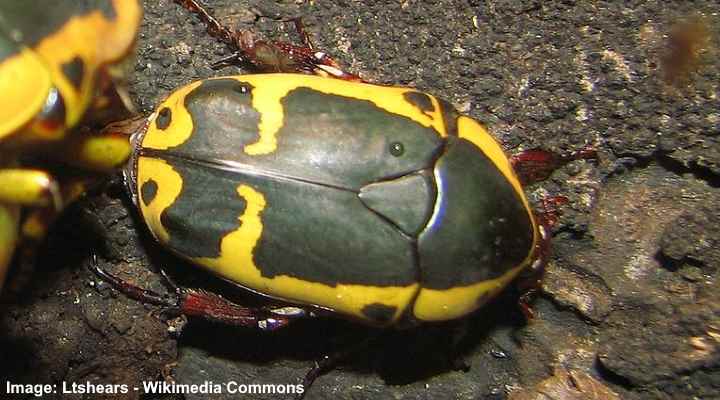
The yellow-bellied beetle has an oval flat yellow and black body with brown head and legs
The yellow-bellied beetle is a large black and yellow beetle with a broadly oval shape. The yellow beetle has a large shield-shaped marking on its back with two black spots at its tail end. Other features of the beetle include reddish-brown legs, head, and stout, clubbed antennae.
Yellow-bellied beetles get their name from their brightly colored yellow underside. This easy-to-identify garden beetle has a flattened shape and measures 0.79” to 2” (20 – 25 mm). There are also color variations with this beetle species, with some having red wing cases with complex black patterns.
Yellow-bellied beetle identification
- A broad, oval beetle with yellow elytra and distinctive black markings.
- The scarab beetles feed on fruits during the daytime.
Flower Longhorn Beetle (Typocerus sparsus)
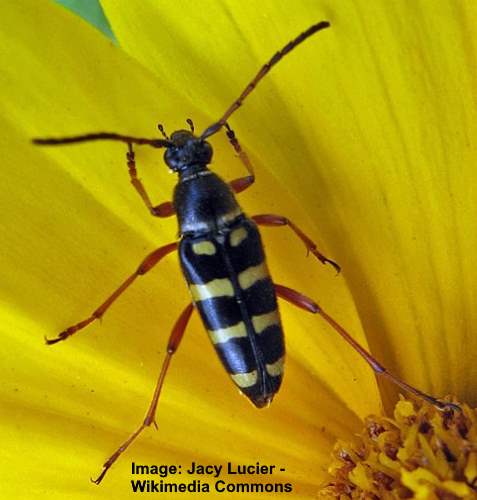
The black and yellow flower longhorn beetle has elongated body with long brown legs
The flower longhorn beetle is a type of black insect with yellow stripes that looks like a wasp. Characteristics of this striped beetle are its slender body, long thread-like antenna, and spindly reddish-brown legs. This yellow-banded black beetle measures 0.43” (11 mm) long. You’ll often find the wasp-like beetle feeding on flower nectar during summer.
Flower longhorn beetle identification
- A black beetle with yellow bands traversing its elytra.
- Rusty brown legs and antennae.
- One of the several beetle species that resemble wasps.
Eurasian Bee Beetle (Trichius fasciatus)
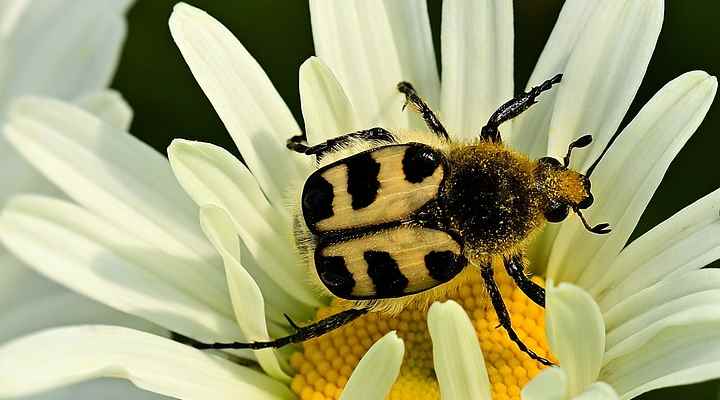
The Eurasian bee beetle is identified by its pale yellow body with black patches and short antennae
The fuzzy black and yellow Eurasian bee beetle has a broadly oval shape and pale-yellow elytra with three large black spots on each. The beetle’s hairy thorax and fine yellow hairs around its abdomen make this unusual beetle look like a bumblebee. This small Eurasian bee beetle measures 0.39” (10 mm).
The Eurasian bee beetle is easy to confuse with bees because it also feeds on flower nectar and pollen. The bee-like flying beetles are active from May through July. Other characteristics of the beetle are its long black hind legs, short, clubbed antennae, and large bulging eyes.
Eurasian bee beetle identification
- The Eurasian bee beetle is a hairy insect with a band of creamy white hair around its elytra and yellow fuzz on its black thorax and head.
- Scarab beetle with black blotches on flattened yellow wing cases.
Tansy Beetle (Chrysolina graminis)
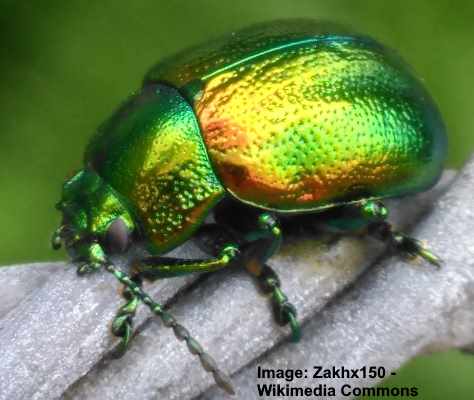
The metallic green and gold tansy beetle has a small rounded body with segmented antennae and short legs
The tansy beetle is a striking green beetle with distinctive bright metallic gold and green colors. Apart from its iridescent colors, the beetle is identified by its short legs, dimpled shiny green and gold wing covers, and green thread-like antennae. The brightly colored beetles measure 0.27” to 0.47” (7 – 12 mm).
Tansy beetles are active throughout summer, feeding on water mint, tansy plants, and chrysanthemums. The iridescent green beetle is similar to the metallic green mint beetle (Chrysolina herbacea).
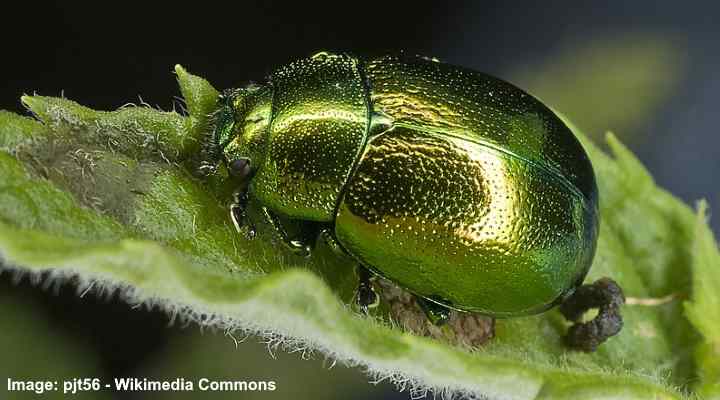
The small mint leaf beetle (Chrysolina herbacea) has a pitted metallic green body with a gold shine
Tansy beetle identification
- The beetle has a metallic green and gold head, thorax, legs, and elytra.
- Look for tiny perforations across its wing cases and thorax.
- It has long, segmented antennae.
Green Scarab Beetle (Heterorrhina elegans)
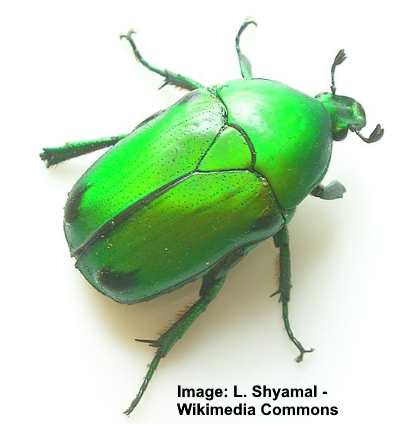
The big green scarab beetle has a shiny body with triangular marking on the back and small antennae
The green scarab beetle is an oval-shaped emerald-green beetle with a distinguishing black mark at the base of each wing cover. The shiny green beetle has short, clubbed antennae, green legs, and a tiny green head. These mid-sized beetles measure 0.78” to 1.18” (20 – 30 mm).
This type of glossy green scarab beetle can appear red, indigo, blue, or black. A member of flower chafer beetles, the shiny green beetle is native to India and Sri Lanka, where it’s commonly found feeding on flower pollen and nectar.
Green scarab beetle identification
- Shiny green wing cases with a smooth surface
- Small head with minute clubbed antennae
Larder Beetles (Dermestes lardarius)
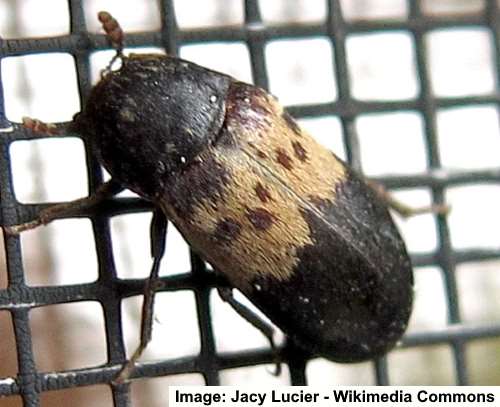
The small brown and black larder beetle is a domestic beetle pest that feeds on dried foodstuff
The larder beetle is a small fuzzy black beetle with a beige or dull tan-colored band across its back. The identifying feature of these annoying kitchen pests is the three dots on each wing case. The brownish-black beetle has a rounded thorax and an overall oval shape. Larder beetles measure 0.33” to 0.37” (8 – 9.5 mm).
Also called moisture bugs, larder beetles can become bugs when they infest pantries. The tiny beetles feed on dried meats, cheese, grain, and pet food. You will typically find them indoors during spring and early summer. These bug-like beetles also lay eggs near food sources where the eggs hatch and produce larvae.
Larder beetle identification
- The small beetle is shaped like a coffee bean covered in fine black or reddish-brown setae.
- Look for the identifiable, yellow-spotted band with three spots in a triangle shape.
Related articles:

